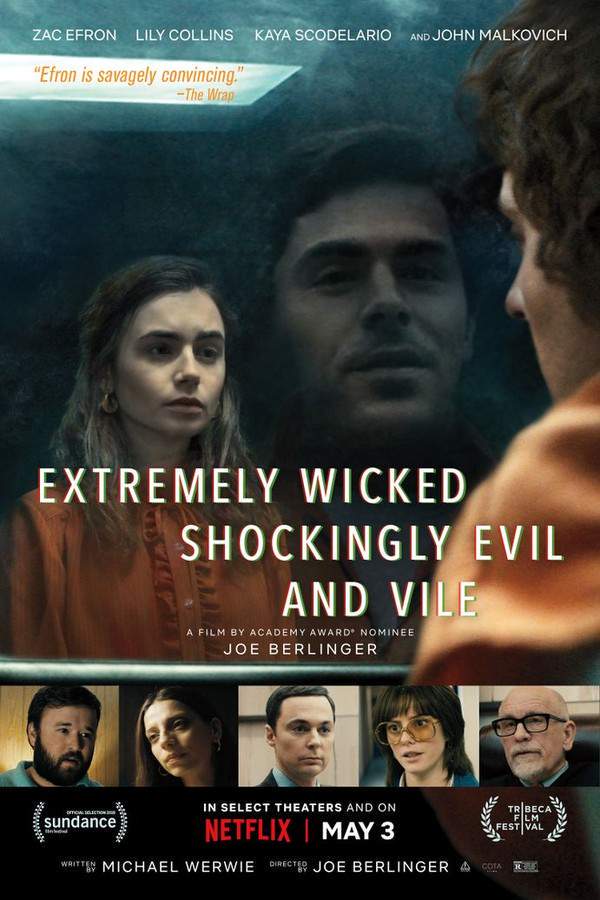
No Man of God
As Ted Bundy faced execution, he shared his most disturbing secrets with FBI agent Bill Hagmaier. The film portrays the unusual relationship that developed between the notorious serial killer and the investigator, examining their interactions in the years before Bundy's death. Through these conversations, the film attempts to illuminate the psychology of a chilling criminal and the complexities of confronting evil.
Warning: spoilers below!
Haven’t seen No Man of God yet? This summary contains major spoilers. Bookmark the page, watch the movie, and come back for the full breakdown. If you're ready, scroll on and relive the story!
No Man of God (2021) – Full Plot Summary & Ending Explained
Read the complete plot breakdown of No Man of God (2021), including all key story events, major twists, and the ending explained in detail. Discover what really happened—and what it all means.
As 1985 unfolds, an unusual set of events leads to the gathering of a select group of FBI agents from the Behavior Science Unit, including the rookie investigator Bill Hagmaier, to engage with Ted Bundy, a notorious death row inmate. Their mission is to delve into Bundy’s psyche, a complex task that Hagmaier willingly embraces despite the known distrust Bundy has for the FBI. Through a series of meaningful exchanges via letters, Bundy starts to open up to Hagmaier, revealing his interests while subtly probing for personal weaknesses.
As the correspondence evolves, Hagmaier makes a visit to Florida State Prison to confront Bundy in person. Here, the discussion takes a darker turn as they explore the themes of pornography and detective magazines as potential influencers of serial killer behavior. Bundy masterfully guides the dialogue, extracting intimate details from Hagmaier’s life and creating a bond of trust between them. He provides a chilling analogy, comparing investigators to fishermen: the deeper they cast their lines, the more elusive the catch becomes. Bundy ominously suggests that one day, he might take Hagmaier on a metaphorical journey to explore the depths of his psyche.
The year 1986 sees Hagmaier returning to the prison for another meeting with Bundy, and this time they examine a collection of crime scene photographs related to the infamous Green River case. As Bundy analyzes this complex case, he begins to share more of his psychological insights, unraveling the twisted logic that drives his actions.
When Hagmaier reconnects with Bundy in 1987, they engage in a conversation about their children and the innocence of youth. But Bundy becomes aware of Hagmaier’s deep emotional involvement and taunts him, inciting him to contemplate what he would do if he were to escape. Hagmaier’s unsettlingly accurate response elicits a fierce reaction from Bundy, who then divulges personal insights, challenging the very foundations of Hagmaier’s beliefs about him. In a poignant moment, Bundy asserts that he and Hagmaier could easily switch places, piercing through Hagmaier’s psyche.
As Ted’s execution by electrocution approaches in 1989, with only a week left for appeals, the situation escalates into a media spectacle, with crowds gathering outside the prison demanding answers. Bundy insists that he must confess his crimes, but he believes that only Hagmaier can facilitate this process. However, when Carolyn Lieberman arrives to represent Bundy, she takes control of the situation, wary of Hagmaier’s FBI connections.
Despite Carolyn’s reservations, Bundy adamantly demands Hagmaier’s presence during the critical confessions. Throughout the interviews with various state investigators, Bundy admits to a staggering number of murders—30 in total. Meanwhile, Carolyn sets up a meeting between Bundy and Dr. James Dobson, hoping that his influence might grant Bundy a reprieve. However, after their discussion, Dobson reveals to Carolyn a harsh truth: the governor has no intention of granting clemency.
In the days leading to his execution, Bundy’s mental clarity begins to slip, prompting a last-minute sanity hearing where Hagmaier’s testimony is vital in assessing Bundy’s fitness for execution. Ultimately, the psychiatric board determines that Bundy is sane, allowing the execution process to move forward.
As the execution day looms, Hagmaier engages in a heartbreaking dialogue with Bundy, who candidly recounts the murder of one of his victims, leaving Hagmaier shaken. In a moment cloaked in tension, Bundy expresses gratitude for their bond, yet also reveals his suicidal thoughts, his expression illuminated by a desperate intensity. Hagmaier’s response is stark and challenging: > “Your victims didn’t prepare for death.”
This moment resonates heavily between them as the reality of Bundy’s actions is laid bare. In the warden’s office, Hagmaier learns that he will not be part of the execution, reducing him to merely an observer. Alone and overwhelmed by the circumstances, he reaches out to his son, sharing a fleeting moment of connection as the outside world buzzes with news of Bundy’s death.
The atmosphere bursts with anticipation and mixed emotions as cheers erupt beyond the prison walls, signaling a chilling reminder that justice, while delivered, may not always lead to satisfaction for those entangled in its web.
Last Updated: November 19, 2024 at 20:41
Ending Explained – What Happens at the End of No Man of God?
Still wondering what the ending of No Man of God (2021) really means? Here’s a spoiler-heavy breakdown of the final scene, major twists, and the deeper themes that shape the film’s conclusion.
At the end of No Man of God, the film leaves viewers with a haunting reflection on the nature of evil and accountability. After years of engaging in a psychological cat-and-mouse game, FBI profiler Bill Hagmaier refuses to grant Ted Bundy the satisfaction of revealing his true motivation. When Bundy, during their final conversation, asks Hagmaier why he thinks he killed, Hagmaier simply responds, “because you wanted to.” This blunt statement silences Bundy’s manipulative attempts to justify his actions, emphasizing that his crimes are rooted in a desire driven by his own twisted will rather than external influences or excuses. The scene culminates in Bundy offering a chilling and unrepentant admission of guilt—an unfiltered glimpse into his monstrous psyche—and, in doing so, dehumanizes himself further, showing that his motivations are merely about satisfying his own lust for power and control.
Meanwhile, the film’s concluding images and Hagmaier’s final reflections underscore a complex stance on justice and morality. The last shot features Hagmaier watching a hostile crowd celebrating Bundy’s execution, a moment that prompts viewers to question whether capital punishment is the just response to such evil or whether it simply perpetuates a cycle of violence. The movie refrains from providing easy answers, instead inviting the audience to consider the human capacity for evil, the dangers of idolizing such figures, and the importance of acknowledging the voices and victims silenced by Bundy. Throughout, No Man of God emphasizes the disturbing ease with which evil can be masked by normalcy, and how understanding—while crucial—is no excuse for allowing such horrors to go unpunished. The ending leaves us with a haunting sense of the unresolved tension between justice, humanity, and the lingering shadows of evil.
Last Updated: June 25, 2025 at 09:00
Unlock the Full Story of No Man of God
Don't stop at just watching — explore No Man of God in full detail. From the complete plot summary and scene-by-scene timeline to character breakdowns, thematic analysis, and a deep dive into the ending — every page helps you truly understand what No Man of God is all about. Plus, discover what's next after the movie.
No Man of God Timeline
Track the full timeline of No Man of God with every major event arranged chronologically. Perfect for decoding non-linear storytelling, flashbacks, or parallel narratives with a clear scene-by-scene breakdown.

Characters, Settings & Themes in No Man of God
Discover the characters, locations, and core themes that shape No Man of God. Get insights into symbolic elements, setting significance, and deeper narrative meaning — ideal for thematic analysis and movie breakdowns.

No Man of God Ending Explained
What really happened at the end of No Man of God? This detailed ending explained page breaks down final scenes, hidden clues, and alternate interpretations with expert analysis and viewer theories.

Similar Movies to No Man of God
Discover movies like No Man of God that share similar genres, themes, and storytelling elements. Whether you’re drawn to the atmosphere, character arcs, or plot structure, these curated recommendations will help you explore more films you’ll love.
Explore More About Movie No Man of God
No Man of God (2021) Scene-by-Scene Movie Timeline
No Man of God (2021) Movie Characters, Themes & Settings
No Man of God (2021) Ending Explained & Theories
No Man of God (2021) Spoiler-Free Summary & Key Flow
Movies Like No Man of God – Similar Titles You’ll Enjoy
Extremely Wicked, Shockingly Evil and Vile (2019) Spoiler-Packed Plot Recap
Ted K (2022) Film Overview & Timeline
The Jeffrey Dahmer Files (2013) Complete Plot Breakdown
Aileen: Life and Death of a Serial Killer (2004) Plot Summary & Ending Explained
Ted Bundy (2002) Complete Plot Breakdown
Ted Bundy: American Boogeyman (2021) Detailed Story Recap
American Murderer (2022) Complete Plot Breakdown
Ted Bundy: Mind of a Monster (2019) Story Summary & Characters
Conversations with a Killer: The Ted Bundy Tapes (1000) Detailed Story Recap
Murder: No Apparent Motive (1984) Detailed Story Recap
Fatal Addiction: Ted Bundy’s Final Interview (1989) Film Overview & Timeline
The Deliberate Stranger (1986) Detailed Story Recap
Ted Bundy: Falling for a Killer (1000) Story Summary & Characters
Bundy: A Legacy of Evil (2008) Full Summary & Key Details
B.T.K. (2008) Movie Recap & Themes

















